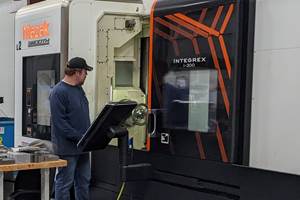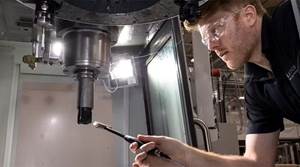Open House Showcases Five-Axis Capabilities, Digital Tools
Five-axis machining technology was the highlight of the Hwacheon open house in Lincolnshire, Illinois this August.
Share





This August, Hwacheon Machinery held an open house at its Lincolnshire, Illinois, facility near Chicago, where it provided insights into its technology, displaying two new five-axis machine tools, as well as its in-house machine monitoring systems: M-Vision Plus and M-Vision Pro. The company also hosted representatives from FANUC to discuss programming for five-axis machining.
Five-Axis Machines for Large Parts
Many manufacturers attended the open house to learn about Hwacheon’s offerings and listen to presentations from partners. At the event, the company revealed its two newest five-axis machine tools: the D3-5AX and M1-5AX.
The event saw the introduction of the Hwacheon D3-5AX and M1-5AX, two five-axis machine tools designed to integrate easily with the company’s own pallet-changing system. The D3 is a trunnion-style five-axis machine capable of both 4+1 and full five-axis machining for large parts. It is the company’s largest five-axis machine, capable of 800 millimeters in X-axis travel and with an 800-millimeter work area. It comes standard with a 12,000-rpm spindle, with options for spindle speeds as high as 24,000 rpm.
The D3-5AX is the largest five-axis machine tool provided by Hwacheon. The work area measures 800 milimeters across, and it comes with a maximum spindle speed of 12,000 rpm.
The M1, on the other hand, is designed specifically for mold and die shops. The work area has a 300-millimeter diameter, and the spindle speeds are available at either 20,000 or 30,000 rpm. The machine’s cooling systems in both the spindle and frame ensure thermal stability over long machining cycles, which is ideal for mold and die work.
Both machine tools come standard with the company’s Harmony control.
Digital Tools, Tangible Results
The Harmony control uses a touchscreen human-machine interface on FANUC guts. Developed in-house, the control makes monitoring machine functions, simulating toolpaths and programming five-axis work accessible through simple menu options. It uses conversational CAM programming, and it has functions to optimize five-axis feed rates and simulate five-axis toolpaths. The system enables users unfamiliar with programming five-axis work to effectively adapt to five-axis machining, and users who are already used to using a FANUC control for five-axis machines can simply switch the interface to the standard FANUC option.
The M1-5AX is designed to serve the needs of die/mold manufacturers, according to Hwacheon.
According to FANUC Aerospace Program Manager Rick Schultz, Hwacheon machines are adept at taking advantage of the control’s five-axis machining features. For example, the Workpiece Setting Error Compensation function enables the machine tool to identify positional errors that can occur during setup and adjust the toolpath to compensate, and the AI Contour Control uses algorithms to optimize toolpaths while taking cutting conditions into account.
“These functions are critical for five-axis machining,” Schultz said in a presentation on programming for five-axis machining, emphasizing that these functions can shorten cycle times and avoid scrapped parts. He also praised Hwacheon machines for taking advantage of these and other features. “Hwacheon is one of the customers using our most current functions. They’re one of the most prepared for five-axis machining.”
Hwacheon’s M-Vision machine monitoring provides real-time information on the uptime of machine tools. With M-Vision Pro, users also get remote access to the data, as well as information regarding the causes of any machine downtime.
In addition to controls, Hwacheon had its M-Vision machine monitoring system on display. M-Vision Plus and M-Vision Pro provide real-time data that can identify spindle utilization and alert users to problems. While both provide machine monitoring, the Pro version enables users to track data remotely, as well as pull up alarms and identify the cause of machine downtime. Visitors to the open house could scan a QR code and automatically download the machine monitoring app, providing them live data for the machine tools on display.
Related Content
5 Tips for Running a Profitable Aerospace Shop
Aerospace machining is a demanding and competitive sector of manufacturing, but this shop demonstrates five ways to find aerospace success.
Read More6 Machine Shop Essentials to Stay Competitive
If you want to streamline production and be competitive in the industry, you will need far more than a standard three-axis CNC mill or two-axis CNC lathe and a few measuring tools.
Read MoreOrthopedic Event Discusses Manufacturing Strategies
At the seminar, representatives from multiple companies discussed strategies for making orthopedic devices accurately and efficiently.
Read MoreHow to Mitigate Chatter to Boost Machining Rates
There are usually better solutions to chatter than just reducing the feed rate. Through vibration analysis, the chatter problem can be solved, enabling much higher metal removal rates, better quality and longer tool life.
Read MoreRead Next
AMRs Are Moving Into Manufacturing: 4 Considerations for Implementation
AMRs can provide a flexible, easy-to-use automation platform so long as manufacturers choose a suitable task and prepare their facilities.
Read MoreLast Chance! 2025 Top Shops Benchmarking Survey Still Open Through April 30
Don’t miss out! 91ÊÓƵÍøÕ¾ÎÛ's Top Shops Benchmarking Survey is still open — but not for long. This is your last chance to a receive free, customized benchmarking report that includes actionable feedback across several shopfloor and business metrics.
Read MoreMachine Shop MBA
Making Chips and 91ÊÓƵÍøÕ¾ÎÛ are teaming up for a new podcast series called Machine Shop MBA—designed to help manufacturers measure their success against the industry’s best. Through the lens of the Top Shops benchmarking program, the series explores the KPIs that set high-performing shops apart, from machine utilization and first-pass yield to employee engagement and revenue per employee.
Read More






















